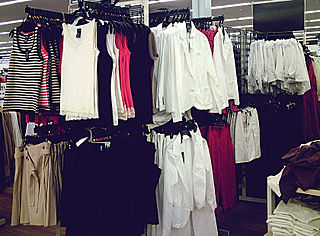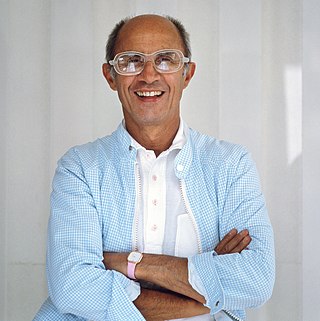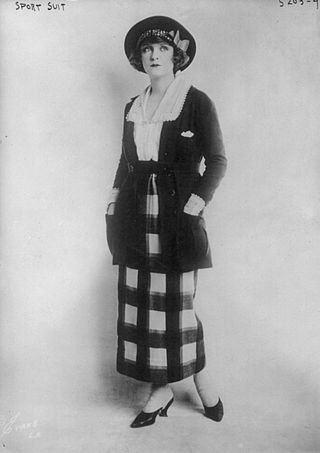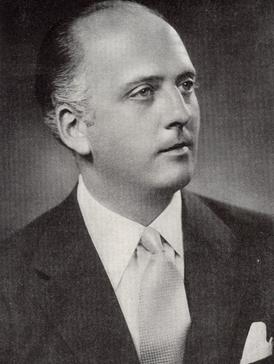Related Research Articles

Yves Henri Donat Mathieu-Saint-Laurent, better known as Yves Saint Laurent or YSL, was a French fashion designer who, in 1962, founded his eponymous fashion label. He is regarded as being among the foremost fashion designers of the twentieth century.

A miniskirt is a skirt with its hemline well above the knees, generally at mid-thigh level, normally no longer than 10 cm (4 in) below the buttocks; and a dress with such a hemline is called a minidress or a miniskirt dress. A micro-miniskirt or microskirt is a miniskirt with its hemline at the upper thigh, at or just below crotch or underwear level.

Ready-to-wear (RTW) – also called prêt-à-porter, or off-the-rack or off-the-peg in casual use – is the term for garments sold in finished condition in standardized sizes, as distinct from made-to-measure or bespoke clothing tailored to a particular person's frame. In other words, it is a piece of clothing that was mass produced in different sizes and sold that way instead of it being designed and sewn for one person. The term off-the-peg is sometimes used for items other than clothing, such as handbags. It is the opposite of haute couture.

Count Hubert James Marcel Taffin de Givenchy was a French aristocrat and fashion designer who founded the luxury fashion and perfume house of Givenchy in 1952. He is famous for having designed much of the personal and professional wardrobe of Audrey Hepburn and clothing for Jacqueline Bouvier Kennedy. He was named to the International Best Dressed List Hall of Fame in 1970.

Sir Norman Bishop Hartnell was a leading British fashion designer, best known for his work for the ladies of the royal family. Hartnell gained the Royal Warrant as Dressmaker to Queen Elizabeth in 1940, and Royal Warrant as Dressmaker to Queen Elizabeth II in 1957. Princess Beatrice also wore a dress designed for Queen Elizabeth II by Hartnell for her wedding in 2020.

André Courrèges was a French fashion designer. He was particularly known for his streamlined 1960s designs influenced by modernism and futurism, exploiting modern technology and new fabrics. Courrèges defined the go-go boot and along with Mary Quant, is one of the designers credited with inventing the miniskirt.

History of fashion design refers specifically to the development of the purpose and intention behind garments, shoes, accessories, and their design and construction. The modern industry, based around firms or fashion houses run by individual designers, started in the 19th century with Charles Frederick Worth who, beginning in 1858, was the first designer to have his label sewn into the garments he created.

Sportswear is an American fashion term originally used to describe separates, but which since the 1930s has come to be applied to day and evening fashions of varying degrees of formality that demonstrate a specific relaxed approach to their design, while remaining appropriate for a wide range of social occasions. The term is not necessarily synonymous with activewear, clothing designed specifically for participants in sporting pursuits. Although sports clothing was available from European haute couture houses and "sporty" garments were increasingly worn as everyday or informal wear, the early American sportswear designers were associated with ready-to-wear manufacturers. While most fashions in America in the early 20th century were directly copied from, or influenced heavily by Paris, American sportswear became a home-grown exception to this rule, and could be described as the American Look. Sportswear was designed to be easy to look after, with accessible fastenings that enabled a modern emancipated woman to dress herself without a maid's assistance.

John Cavanagh was an Irish couturier of the 1950s and 1960s. A member of the Incorporated Society of London Fashion Designers (IncSoc), his style has been described as reflecting Parisian chic. He designed the wedding dresses for the Duchess of Kent in 1961 and for Princess Alexandra in 1963.

Hardy Amies London (Limited) was a UK-based fashion house specializing in modern luxury menswear.

Sir Edwin Hardy Amies KCVO was a British fashion designer, founder of the Hardy Amies label and a Royal Warrant holder as designer to Queen Elizabeth II.

The Incorporated Society of London Fashion Designers was a membership organisation founded in 1942 to promote the British fashion and textile industry and create luxury couture to sell abroad for the war effort. It aimed to build the relationship between government and fashion industry and represent the interests of London couturiers. The organisation continued after the war and sought to present itself as an alternative to the revived Paris couture industry.

Henry Digby Morton (1906–1983) was an Irish fashion designer and among the leading names of British couture in the period from 1930-50. He was also among the pioneers of ready-to-wear fashions in the 1950s. Successful on both sides of the Atlantic, he redefined women's suits and tailoring, earned himself the moniker 'Daring Digby' for his US fashion venture and helped to establish the Incorporated Society of London Fashion Designers, an early forerunner of the British Fashion Council.

Charles Southey Creed was a British fashion designer. Born into the longstanding tailoring house of Henry Creed & Company in Paris, he launched his eponymous label in London in 1946. The first elected member of the Incorporated Society of London Fashion Designers, he had success in both Britain and the United States.

Giuseppe Mattli (1907–1982), usually known as Mattli or Jo Mattli, was a Swiss-born and London-based fashion designer known for his couture designs and, later, his ready-to-wear clothing and couture patterns.

Angele Delanghe, was a Belgian fashion designer based in London who ran an eponymous label from the late 1930s to the mid 1960s and also produced couture designs for the West End department store Fortnum & Mason.

Michael Donnellan (1915–1985) – best known as Michael of Carlos Place and simply Michael – was an Irish-born fashion designer who headed the house of Lachasse from 1941, before running a successful eponymous couture house in London from 1953 to 1971. From the 1960s on, he combined the role of couturier with consultancy to mainstream fashion houses, most notably acting as a key consultant to Marks & Spencer.
Lachasse was a British couture firm operating from 1928 until 2006, making it one of the longest surviving high fashion houses in London.
Reed Crawford (1924-2006) was a British milliner of the 1950s and 1960s. He produced a series of high-fashion designs that matched the Swinging London mood of the 1960s, including helmet-style cloche hats and designs in unusual material combinations, such as plastic and fur. He became especially associated with couture, working with the designer John Cavanagh from 1959 and joining the Incorporated Society of London Fashion Designers as an associate member from 1961.
Alison Adburgham was an English journalist, author and social historian, best known for her work as fashion editor of The Guardian newspaper, a position she held for 20 years. Along with Prudence Glynn of The Times and Alison Settle of The Observer, she pioneered British fashion journalism in a broadsheet national newspaper; as a bylined columnist, influencing public perception of trends in clothing, the industry itself. She also wrote several books on social history.
References
- 1 2 3 4 Hart, John; Adburgham, Alison (23 January 1965). "The Spring Fashion Collections". The Guardian.
- 1 2 3 4 5 6 7 8 "Immortals". The Sydney Morning Herald. 30 August 1964. Retrieved 19 September 2014.
- 1 2 Glynn, Prudence (18 January 1972). "The life and hard times of British couture". The Times. No. 58378. p. 6.
- 1 2 staff (25 January 1965). "Collection notebook: Summing up the London Fashion Shows". The Times. No. 56228. The Times Digital Media Library. p. 15.
- ↑ "Study in dress contrasts". The Times. No. 56227. 23 January 1965.
- 1 2 Pauley, Gay (12 October 1967). "Short skirts will stay says expert". The Dispatch (Lexington). Retrieved 19 September 2014.
- ↑ Adburgham, Alison (29 October 1968). "The Invaders from Wales". The Observer.
- 1 2 3 Adburgham, Alison (5 October 1967). "The Clive Set". The Guardian. p. 6.
- ↑ "Such a bore, says Clive". The Guardian. 5 September 1968.
- ↑ "London shows: are we too understated?". The Times. No. 56688. 20 July 1966. p. 13.
- ↑ Deacon-Smith, Antony (24 October 1969). "Men's Fashion". The Times. No. 57699. p. 15.
- ↑ "BOAC uniforms". British Airways. Retrieved 20 September 2014.
- ↑ Walker, Harriet (April 2013). "Fashion: The chic history of British Airways' Uniforms". High Life. Retrieved 19 September 2014.
- ↑ "BA presents vintage uniform catwalk show". Business Traveller. Retrieved 20 September 2014.
- ↑ Bell, Lynne (16 July 1971). "A shifty way with autumn". The Sydney Morning Herald. Retrieved 21 September 2014.